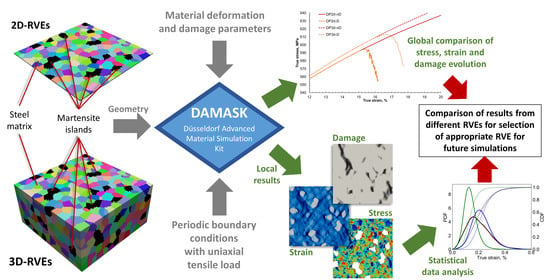Effect of the 3rd Dimension within the Representative Volume Element (RVE) on Damage Initiation and Propagation during Full-Phase Numerical Simulations of Single and Multi-Phase Steels
Abstract
1. Introduction
2. Numerical Simulation Model Development
2.1. RVE Construction and Geometry Files Production
2.2. Material Properties
2.3. Loading Conditions, Processing, and Post Processing
3. Results
- Damage initiation and propagation behavior in single-phase steel compared with non-damage simulation results. The results were recorded to see how do the 2D and 3D RVE considerations—in the case of single-phase steel—affect the damage evolution, and,
- Similarly, for the case of DP-steel, 2D, and 3D RVEs with damage and non-damage criteria are simulated to observe the difference in damage initiation and propagation for the case of multi-phase materials.
3.1. Deformation and Damage Behavior of Single-Phase Steel
3.1.1. Global Behavior
3.1.2. Local Behavior
3.1.3. Statistical Comparison of Local Stresses and Strains
3.2. Deformation and Damage Behavior of DP-Steel
3.2.1. Global Behavior
3.2.2. Local Behavior
3.2.3. Statistical Comparison of Local Stresses and Strains
4. Discussion
- Either it could be taken and understood as it is and be informed that in 2D RVEs, the damage initiates at less strain. Or,
- It can be used to apply a correction factor for increasing the damage criteria by for 2D RVE case to match the results with 3D RVE results.
5. Conclusions
- Numerical simulation modeling approach of damage initiation and propagation in single-phase steel and DP-steel for 2D, and 3D RVEs is successfully developed.
- The damage in case of 2D RVE initiates earlier than in 3D RVE. This should be kept in mind for implementing full phase CP-simulations results to design problems.
- The statistical analysis of the simulation results in the form of PDFs and CDFs for each phase proves to be a viable tool for comparative analysis of the overall mechanical response. The stress and strain distributions in the ferrite phase are similar for single and multi-phase materials. The enhanced mechanical properties of the DP-steel are an outcome of the incorporated hard martensite phase, which undergoes true strains close to 0.02% and stresses as high as 1.5 GPa.
- Similar to what has been reported in the literature before, it is observed that the local damage initiation and evolution in single-phase steel is at triple points or grain boundaries which propagates to the deformation direction. The local damage in DP-steel is at the ferrite-martensite grain boundaries or in the ferrite grains between the martensite islands and propagates in a complex network.
- 2D RVEs can be adopted to reasonably predict where and when the damage will initiate in the matrix, but the 3D RVEs should be adopted to predict the consistent and reliable results regarding the evolution of the damage network matrix degradation. Experimental validation of these results is needed to be carried out in future.
Author Contributions
Funding
Data Availability Statement
Acknowledgments
Conflicts of Interest
Abbreviations
| RVE | Representative Volume Element | – |
| EBSD | Electron Back Scatter Diffraction | – |
| CP | Crystal Plasticity | – |
| TRIP | Transformation Induced Plasticity | – |
| ESD | Estimated Sphere Diameter | – |
| Mg-PSZ | Magnesium Partially Stabilized Zirconia | – |
| Probability Distribution Function | – | |
| CDF | Cumulative Distribution Function | – |
| ODF | Orientation Distribution Function | – |
| -D- | Damage Case | – |
| -nD- | Non-Damage Case | – |
| IPF | Inverse Pole Figure | – |
| 2D | Two Dimensional (geometry) | – |
| 3D | Three Dimensional (geometry) | – |
| FFT | Fast Fourier Transformation | – |
| Number of considered grains | – | |
| Mean feature estimated sphere diameter | m | |
| Interface energy | Jm | |
| Characteristic length | m | |
| Macroscopic rate of the deformation gradient | s | |
| Macroscopic first Piola–Kirchhoff stress tensor | Pa | |
| M | Damage mobility | s |
| Critical plastic strain | – |
Appendix A. Phenomenological Crystal Plasticity Model

References
- Lula, R.A. Stainless Steel; American Society for Metals: Metals Park, OH, USA, 1985. [Google Scholar]
- Seo, E.J.; Cho, L.; Estrin, Y.; De Cooman, B.C. Microstructure-mechanical properties relationships for quenching and partitioning (Q&P) processed steel. Acta Mater. 2016, 113, 124–139. [Google Scholar]
- Bhadeshia, H.; Honeycombe, R. Steels: Microstructure and Properties; Butterworth-Heinemann: Oxford, UK, 2017. [Google Scholar]
- Bugat, S.; Besson, J.; Gourgues, A.F.; N’Guyen, F.; Pineau, A. Microstructure and damage initiation in duplex stainless steels. Mater. Sci. Eng. A 2001, 317, 32–36. [Google Scholar] [CrossRef]
- Umar, M.; Qayyum, F.; Farooq, M.U.; Khan, L.A.; Guk, S.; Prahl, U. Investigating the effect of cementite particle size and distribution on local stress and strain evolution in spheroidized medium carbon steels using crystal plasticity-based numerical simulations. Steel Res. Int. 2020. [Google Scholar] [CrossRef]
- Duesbery, M. Dislocation motion, constriction and cross-slip in fcc metals. Model. Simul. Mater. Sci. Eng. 1998, 6, 35. [Google Scholar] [CrossRef]
- Qayyum, F.; Guk, S.; Kawalla, R.; Prahl, U. Experimental investigations and multiscale modeling to study the effect of sulfur content on formability of 16MnCr5 alloy steel. Steel Res. Int. 2019, 90, 1800369. [Google Scholar] [CrossRef]
- Ullah, M.; Wu, C.S.; Qayyum, F. Prediction of crack tip plasticity induced due to variation in solidification rate of weld pool and its effect on fatigue crack propagation rate (FCPR). J. Mech. Sci. Technol. 2018, 32, 3625–3635. [Google Scholar] [CrossRef]
- Besson, J. Damage of ductile materials deforming under multiple plastic or viscoplastic mechanisms. Int. J. Plast. 2009, 25, 2204–2221. [Google Scholar] [CrossRef]
- Besson, J.; Cailletaud, G.; Chaboche, J.L.; Forest, S. Mécanique non Linéaire des Matériaux; Hermès Science Publ.: Paris, France, 2001. [Google Scholar]
- Ghadbeigi, H.; Pinna, C.; Celotto, S.; Yates, J. Local plastic strain evolution in a high strength dual-phase steel. Mater. Sci. Eng. A 2010, 527, 5026–5032. [Google Scholar] [CrossRef]
- Ghadbeigi, H.; Pinna, C.; Celotto, S. Failure mechanisms in DP600 steel: Initiation, evolution and fracture. Mater. Sci. Eng. A 2013, 588, 420–431. [Google Scholar] [CrossRef]
- Kumar, A.; Dutta, A.; Makineni, S.K.; Herbig, M.; Petrov, R.; Sietsma, J. In-situ observation of strain partitioning and damage development in continuously cooled carbide-free bainitic steels using micro digital image correlation. Mater. Sci. Eng. A 2019, 757, 107–116. [Google Scholar] [CrossRef]
- Abedini, A.; Butcher, C.; Worswick, M.J. Experimental fracture characterisation of an anisotropic magnesium alloy sheet in proportional and non-proportional loading conditions. Int. J. Solids Struct. 2018, 144, 1–19. [Google Scholar] [CrossRef]
- Gupta, A.; Cecen, A.; Goyal, S.; Singh, A.K.; Kalidindi, S.R. Structure–property linkages using a data science approach: Application to a non-metallic inclusion/steel composite system. Acta Mater. 2015, 91, 239–254. [Google Scholar] [CrossRef]
- Roters, F.; Diehl, M.; Shanthraj, P.; Eisenlohr, P.; Reuber, C.; Wong, S.L.; Maiti, T.; Ebrahimi, A.; Hochrainer, T.; Fabritius, H.O.; et al. DAMASK–The Düsseldorf Advanced Material Simulation Kit for modeling multi-physics crystal plasticity, thermal, and damage phenomena from the single crystal up to the component scale. Comput. Mater. Sci. 2019, 158, 420–478. [Google Scholar] [CrossRef]
- Diehl, M.; An, D.; Shanthraj, P.; Zaefferer, S.; Roters, F.; Raabe, D. Crystal plasticity study on stress and strain partitioning in a measured 3D dual phase steel microstructure. Phys. Mesomech. 2017, 20, 311–323. [Google Scholar] [CrossRef]
- Diehla, M.; Naunheim, Y.; Yan, D.; Morsdorf, L.; An, D.; Tasan, C.C.; Zaefferer, S.; Roters, F.; Raabe, D. Coupled Experimental-Numerical Analysis of Strain Partitioning in Metallic Microstructures: The Importance of Considering the 3D Morphology. In Proceedings of the BSSM 12th International Conference on Advances in Experimental Mechanics, Sheffield, UK, 29–31 August 2017; pp. 1–2. [Google Scholar]
- Diehl, M.; Groeber, M.; Haase, C.; Molodov, D.A.; Roters, F.; Raabe, D. Identifying Structure–Property Relationships Through DREAM.3D Representative Volume Elements and DAMASK Crystal Plasticity Simulations: An Integrated Computational Materials Engineering Approach. Jom 2017, 69, 848–855. [Google Scholar] [CrossRef]
- Eisenlohr, P.; Diehl, M.; Lebensohn, R.A.; Roters, F. A spectral method solution to crystal elasto-viscoplasticity at finite strains. Int. J. Plast. 2013, 46, 37–53. [Google Scholar] [CrossRef]
- Qayyum, F.; Guk, S.; Prüger, S.; Schmidtchen, M.; Saenko, I.; Kiefer, B.; Kawalla, R.; Prahl, U. Investigating the local deformation and transformation behavior of sintered X3CrMnNi16-7-6 TRIP steel using a calibrated crystal plasticity-based numerical simulation model. Int. J. Mater. Res. (Former. Z. FüR Met.) 2020. [Google Scholar] [CrossRef]
- Qayyum, F.; Guk, S.; Schmidtchen, M.; Kawalla, R.; Prahl, U. Modeling the Local Deformation and Transformation Behavior of Cast X8CrMnNi16-6-6 TRIP Steel and 10% Mg-PSZ Composite Using a Continuum Mechanics-Based Crystal Plasticity Model. Crystals 2020, 10, 221. [Google Scholar] [CrossRef]
- Qayyum, F.; Chaudhry, A.A.; Guk, S.; Schmidtchen, M.; Kawalla, R.; Prahl, U. Effect of 3D Representative Volume Element (RVE) Thickness on Stress and Strain Partitioning in Crystal Plasticity Simulations of Multi-Phase Materials. Crystals 2020, 10, 944. [Google Scholar] [CrossRef]
- Jafari, M.; Ziaei-Rad, S.; Saeidi, N.; Jamshidian, M. Micromechanical analysis of martensite distribution on strain localization in dual phase steels by scanning electron microscopy and crystal plasticity simulation. Mater. Sci. Eng. A 2016, 670, 57–67. [Google Scholar] [CrossRef]
- Zhou, J.; Gokhale, A.M.; Gurumurthy, A.; Bhat, S.P. Realistic microstructural RVE-based simulations of stress–strain behavior of a dual-phase steel having high martensite volume fraction. Mater. Sci. Eng. A 2015, 630, 107–115. [Google Scholar] [CrossRef]
- Wang, D.; Shanthraj, P.; Springer, H.; Raabe, D. Particle-induced damage in Fe–TiB2 high stiffness metal matrix composite steels. Mater. Des. 2018, 160, 557–571. [Google Scholar] [CrossRef]
- Ayatollahi, M.; Darabi, A.C.; Chamani, H.; Kadkhodapour, J. 3D micromechanical modeling of failure and damage evolution in dual phase steel based on a real 2D microstructure. Acta Mech. Solida Sin. 2016, 29, 95–110. [Google Scholar] [CrossRef]
- Vajragupta, N.; Uthaisangsuk, V.; Schmaling, B.; Münstermann, S.; Hartmaier, A.; Bleck, W. A micromechanical damage simulation of dual phase steels using XFEM. Comput. Mater. Sci. 2012, 54, 271–279. [Google Scholar] [CrossRef]
- Shanthraj, P.; Sharma, L.; Svendsen, B.; Roters, F.; Raabe, D. A phase field model for damage in elasto-viscoplastic materials. Comput. Methods Appl. Mech. Eng. 2016, 312, 167–185. [Google Scholar] [CrossRef]
- Shanthraj, P.; Svendsen, B.; Sharma, L.; Roters, F.; Raabe, D. Elasto-viscoplastic phase field modelling of anisotropic cleavage fracture. J. Mech. Phys. Solids 2017, 99, 19–34. [Google Scholar] [CrossRef]
- Groeber, M.A.; Jackson, M.A. DREAM. 3D: A digital representation environment for the analysis of microstructure in 3D. Integr. Mater. Manuf. Innov. 2014, 3, 5. [Google Scholar] [CrossRef]
- Tasan, C.C.; Hoefnagels, J.P.M.; Diehl, M.; Yan, D.; Roters, F.; Raabe, D. Strain localization and damage in dual phase steels investigated by coupled in-situ deformation experiments and crystal plasticity simulations. Int. J. Plast. 2014, 63, 198–210. [Google Scholar] [CrossRef]
- Jiang, Z.; Guan, Z.; Lian, J. Effects of microstructural variables on the deformation behaviour of dual-phase steel. Mater. Sci. Eng. A 1995, 190, 55–64. [Google Scholar] [CrossRef]
- Abedini, A.; Butcher, C.; Chen, Z. Numerical simulation of the influence of particle clustering on tensile behavior of particle-reinforced composites. Comput. Mater. Sci. 2013, 73, 15–23. [Google Scholar] [CrossRef]
- Barrett, T.J.; Savage, D.J.; Ardeljan, M.; Knezevic, M. An automated procedure for geometry creation and finite element mesh generation: Application to explicit grain structure models and machining distortion. Comput. Mater. Sci. 2018, 141, 269–281. [Google Scholar] [CrossRef]
- Tjahjanto, D.; Turteltaub, S.; Suiker, A. Crystallographically based model for transformation-induced plasticity in multiphase carbon steels. Contin. Mech. Thermodyn. 2008, 19, 399–422. [Google Scholar] [CrossRef]
- Ahrens, J.; Geveci, B.; Law, C. Paraview: An end-user tool for large data visualization. Vis. Handb. 2005, 717, 1–17. [Google Scholar]
- Archie, F.; Li, X.; Zaefferer, S. Micro-damage initiation in ferrite-martensite DP microstructures: A statistical characterization of crystallographic and chemical parameters. Mater. Sci. Eng. A 2017, 701, 302–313. [Google Scholar] [CrossRef]
- Yan, D.; Tasan, C.C.; Raabe, D. High resolution in situ mapping of microstrain and microstructure evolution reveals damage resistance criteria in dual phase steels. Acta Mater. 2015, 96, 399–409. [Google Scholar] [CrossRef]
- Ullah, M.; Qayyum, F.; Elahi, H.; Mukhtar, F.; Ali, Q.; Abbas, C.A. Influence of microstructural evolution and localized delta ferrite number on high-cycle fatigue crack opening and propagation rate. Proc. Inst. Mech. Eng. Part L J. Mater. Des. Appl. 2020. [Google Scholar] [CrossRef]

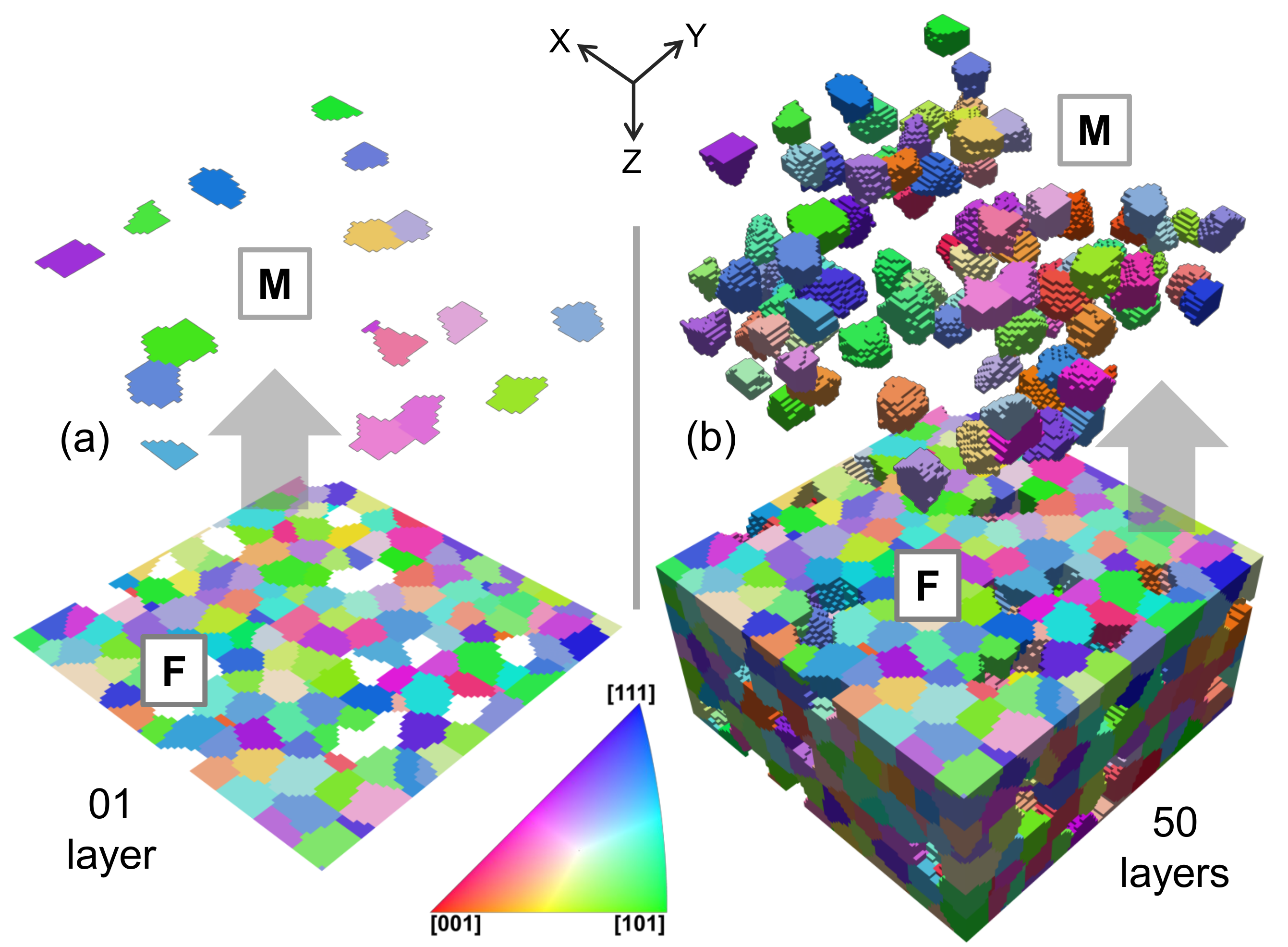
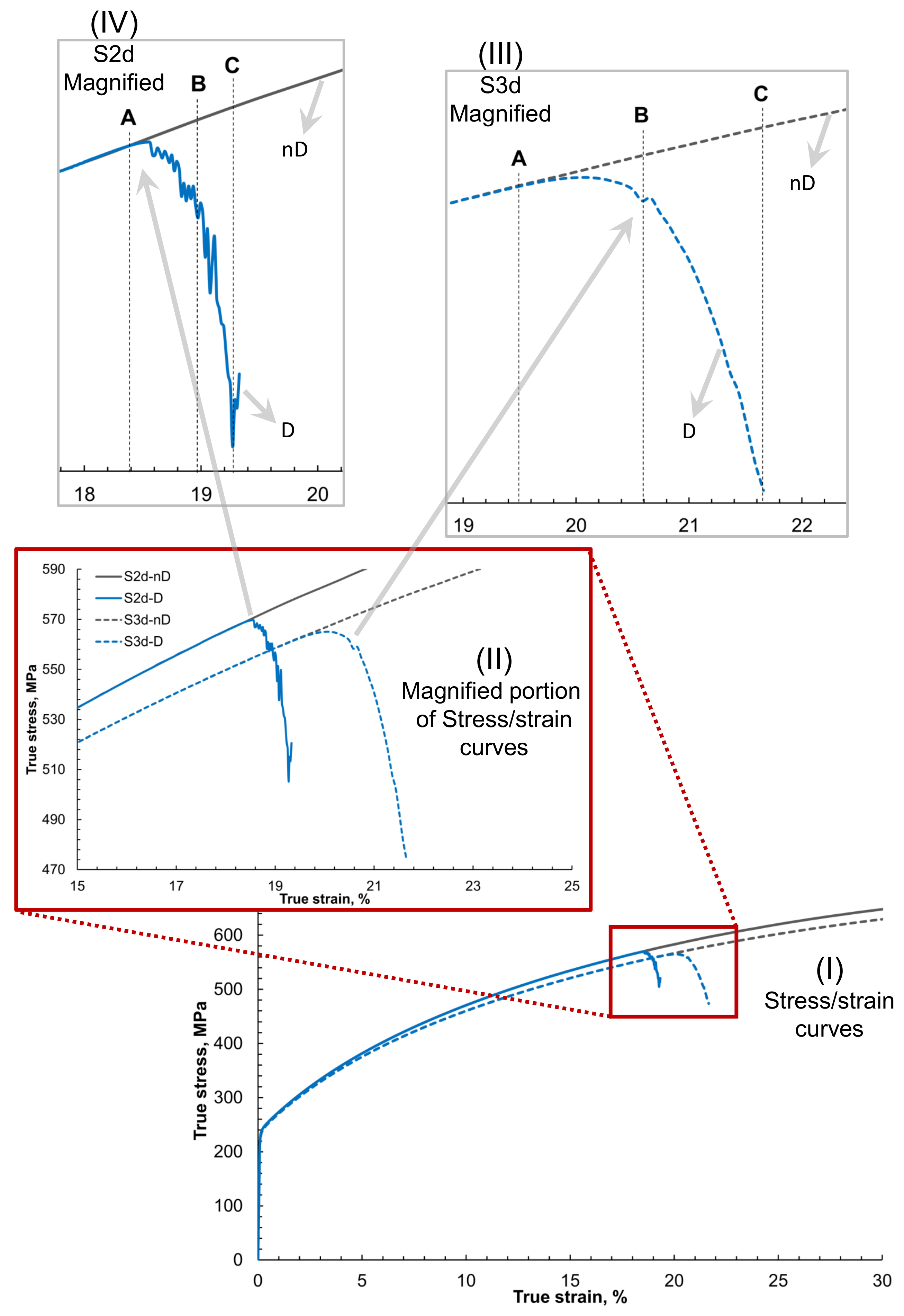

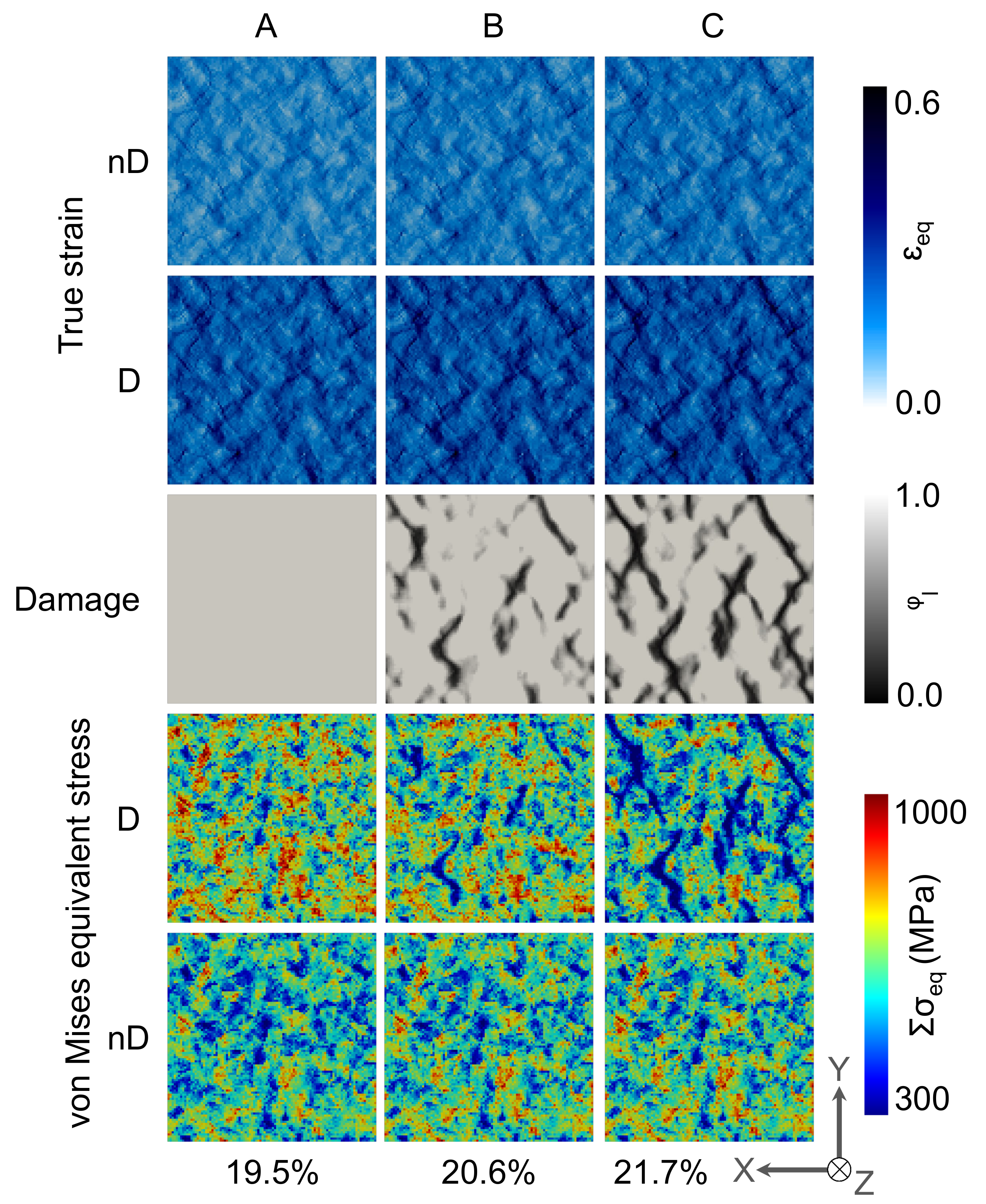

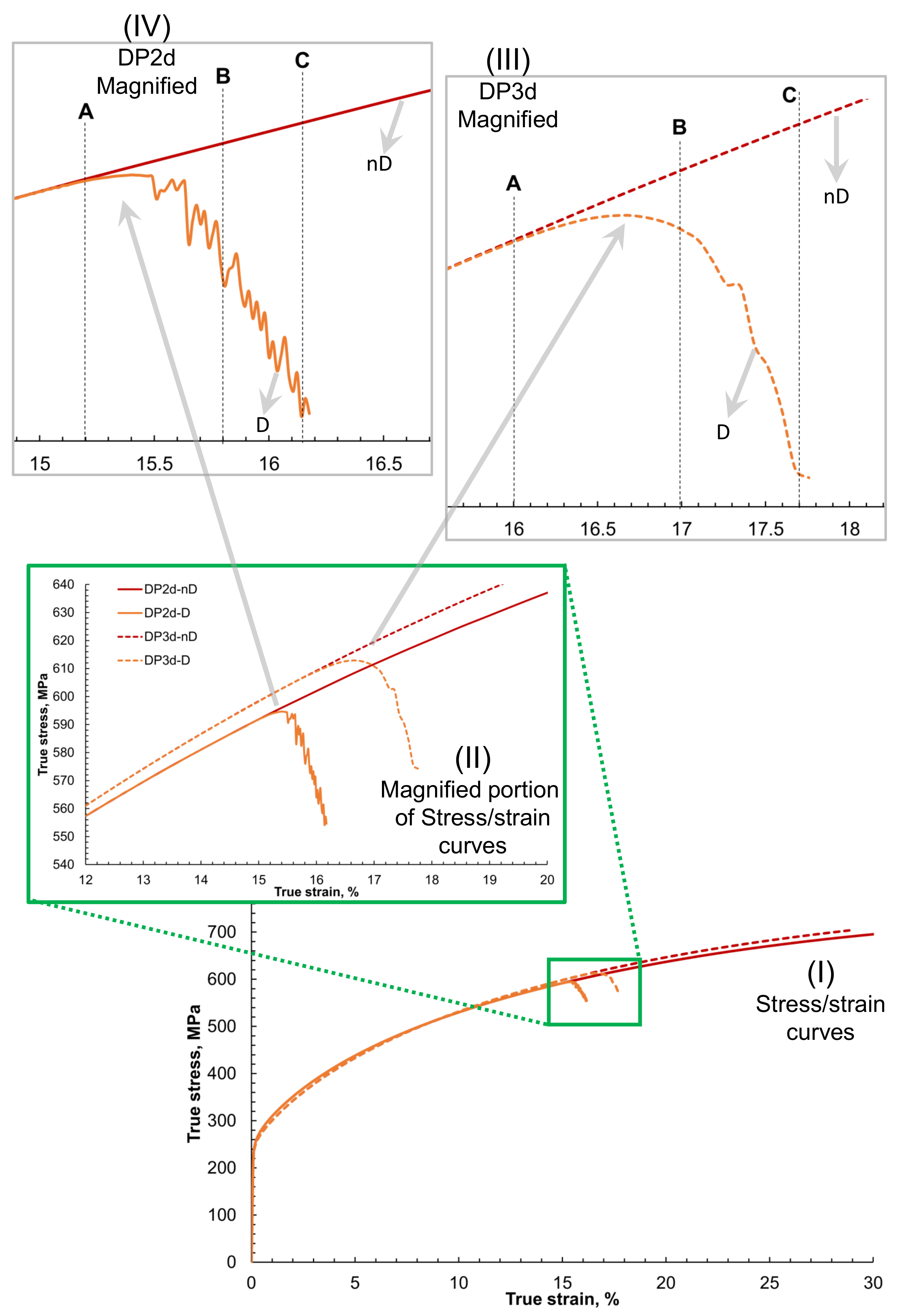

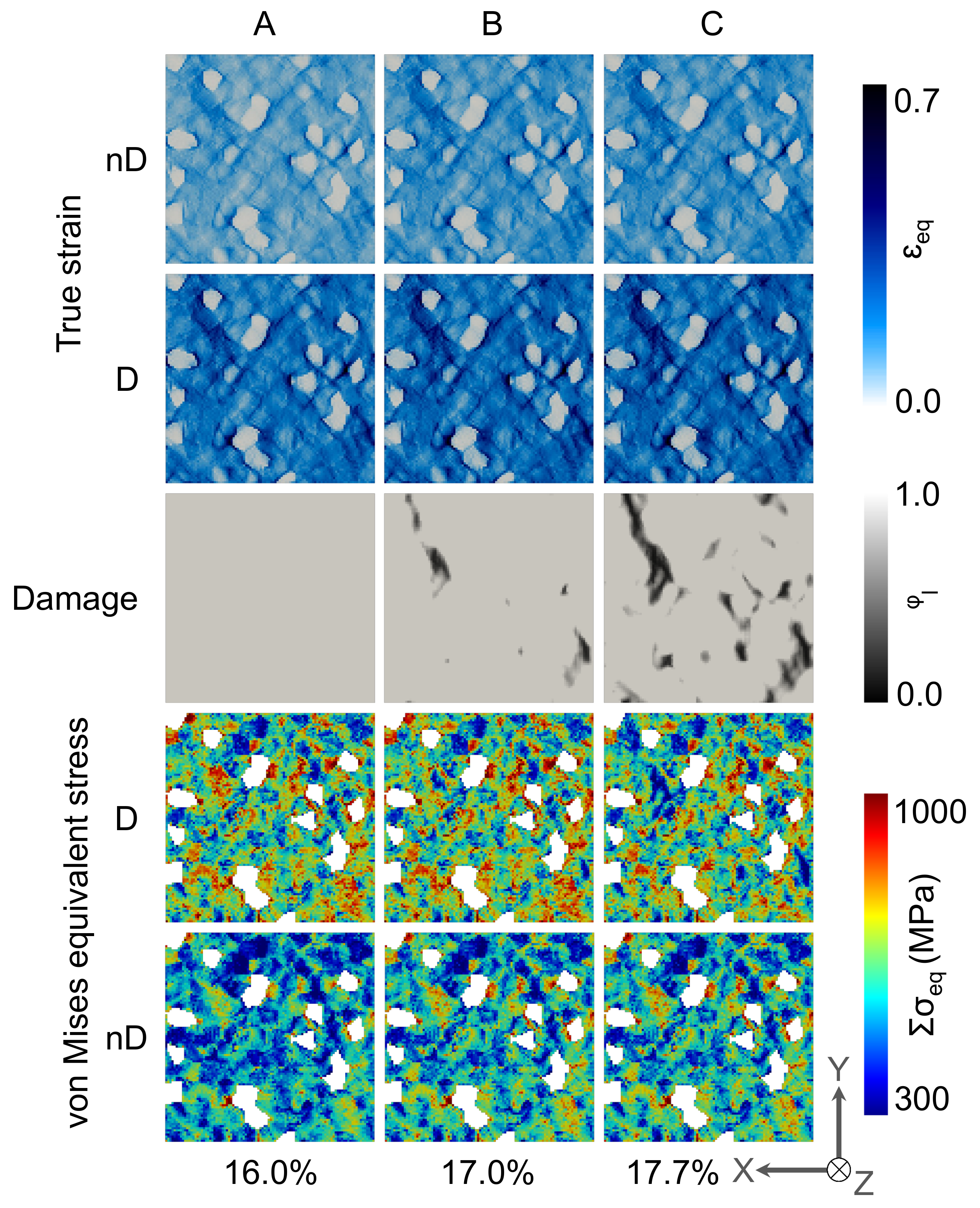
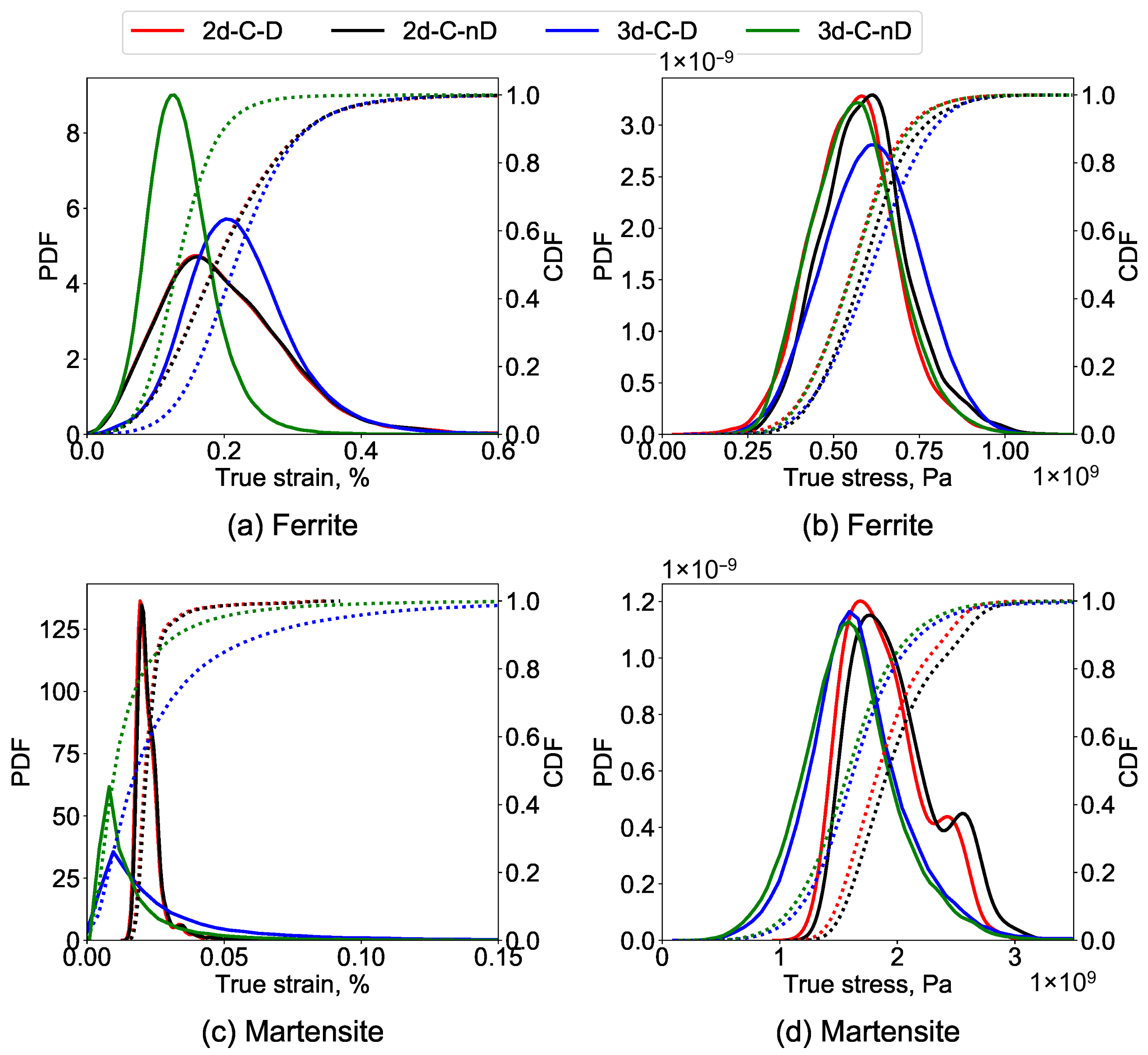

| Parameter Definition | Symbols | Attributes for Ferrite | Attributes for Martensite | Unit |
|---|---|---|---|---|
| First elastic stiffness constant with normal strain | 233.3 | 417.4 | GPa | |
| Second elastic stiffness constant with normal strain | 135.5 | 242.4 | GPa | |
| First elastic stiffness constant with shear strain | 128.0 | 211.1 | GPa | |
| Shear Strain rate | 1 | 1 | /s | |
| Initial Shear resistance on | 95 | 406 | MPa | |
| Saturation shear resistance on | 222 | 873 | MPa | |
| Initial Shear resistance on | 96 | 457 | MPa | |
| Saturation shear resistance on | 412 | 971 | MPa | |
| Slip hardening parameter | 1000 | 563 | MPa | |
| Interaction hardening parameter | 1.0 | 1.0 | - | |
| Stress exponent | n | 20 | 20 | - |
| Curve fitting parameter | w | 2.0 | 2.0 | - |
| Parameter Definition | Symbols | Value | Unit |
|---|---|---|---|
| Interface energy | 1.0 | J m−2 | |
| Characteristic length | 1.5 | μm | |
| Damage mobility | M | 0.01 | s−1 |
| Damage diffusion | D | 1.0 | - |
| Critical plastic strain | 0.5 | - | |
| Damage rate sensitivity | P | 10 | - |
| Material | RVE Type | Damage Inclusion | Point | Increment | Nomenclature |
|---|---|---|---|---|---|
| DP-steel | 2D | D | A | 1203 | DP2d-A-D |
| B | 1386 | DP2d-B-D | |||
| C | 1437 | DP2d-C-D | |||
| nD | A | 1900 | DP2d-A-nD | ||
| B | 2000 | DP2d-B-nD | |||
| C | 2050 | DP2d-C-nD | |||
| 3D | D | A | 1310 | DP-3d-A-D | |
| B | 1520 | DP3d-B-D | |||
| C | 1600 | DP3d-C-D | |||
| nD | A | 1300 | DP3d-A-nD | ||
| B | 1550 | DP3d-B-nD | |||
| C | 1600 | DP3d-C-nD | |||
| Steel | 2D | D | A | 1600 | S2d-A-D |
| B | 1750 | S2d-B-D | |||
| C | 1770 | S2d-C-D | |||
| nD | A | 2400 | S2d-A-nD | ||
| B | 2550 | S2d-B-nD | |||
| C | 2600 | S2d-C-nD | |||
| 3D | D | A | 1770 | S-3d-A-D | |
| B | 1990 | S3d-B-D | |||
| C | 2080 | S3d-C-D | |||
| nD | A | 1800 | S3d-A-nD | ||
| B | 2000 | S3d-B-nD | |||
| C | 2100 | S3d-C-nD |
Publisher’s Note: MDPI stays neutral with regard to jurisdictional claims in published maps and institutional affiliations. |
© 2020 by the authors. Licensee MDPI, Basel, Switzerland. This article is an open access article distributed under the terms and conditions of the Creative Commons Attribution (CC BY) license (http://creativecommons.org/licenses/by/4.0/).
Share and Cite
Qayyum, F.; Umar, M.; Guk, S.; Schmidtchen, M.; Kawalla, R.; Prahl, U. Effect of the 3rd Dimension within the Representative Volume Element (RVE) on Damage Initiation and Propagation during Full-Phase Numerical Simulations of Single and Multi-Phase Steels. Materials 2021, 14, 42. https://doi.org/10.3390/ma14010042
Qayyum F, Umar M, Guk S, Schmidtchen M, Kawalla R, Prahl U. Effect of the 3rd Dimension within the Representative Volume Element (RVE) on Damage Initiation and Propagation during Full-Phase Numerical Simulations of Single and Multi-Phase Steels. Materials. 2021; 14(1):42. https://doi.org/10.3390/ma14010042
Chicago/Turabian StyleQayyum, Faisal, Muhammad Umar, Sergey Guk, Matthias Schmidtchen, Rudolf Kawalla, and Ulrich Prahl. 2021. "Effect of the 3rd Dimension within the Representative Volume Element (RVE) on Damage Initiation and Propagation during Full-Phase Numerical Simulations of Single and Multi-Phase Steels" Materials 14, no. 1: 42. https://doi.org/10.3390/ma14010042
APA StyleQayyum, F., Umar, M., Guk, S., Schmidtchen, M., Kawalla, R., & Prahl, U. (2021). Effect of the 3rd Dimension within the Representative Volume Element (RVE) on Damage Initiation and Propagation during Full-Phase Numerical Simulations of Single and Multi-Phase Steels. Materials, 14(1), 42. https://doi.org/10.3390/ma14010042









